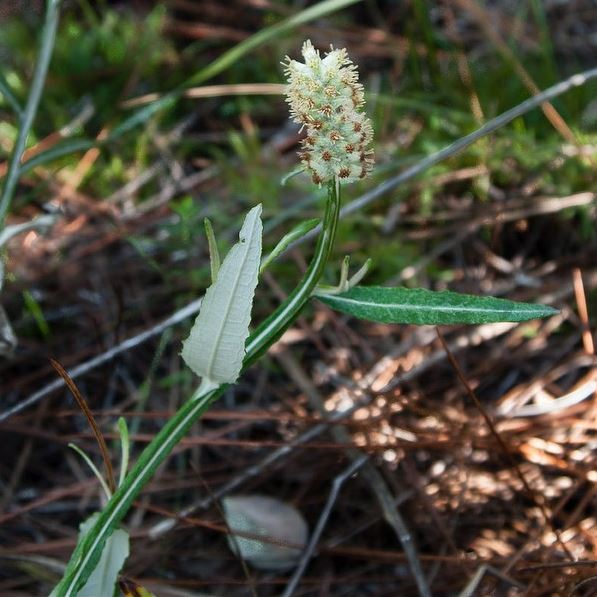Pterocaulon pycnostachyum
Common names: dense-spike blackroot [1], wand or coastal blackroot, rabbit tobacco[2]
| Pterocaulon pycnostachyum | |
|---|---|

| |
| Photo by John Bradford hosted at Bluemelon.com/poaceae | |
| Scientific classification | |
| Kingdom: | Plantae |
| Division: | Magnoliophyta - Flowering plants |
| Class: | Magnoliopsida - Dicots |
| Order: | Asterales |
| Family: | Asteraceae |
| Genus: | Pterocaulon |
| Species: | P. pyconstachyum |
| Binomial name | |
| Pterocaulon pycnostachyum (Michx.) Elliot | |

| |
| Natural range of Pterocaulon pycnostachyum from USDA NRCS Plants Database. | |
Contents
Taxonomic Notes
Synonym: P. undulatum (Walter) C. Mohr
Variety: none
Description
P. pycnostachyum is a perennial forb/subshrub of the Asteraceae family that is native to North America.[1]
According to Diaz-Torbio and Putz (2021), Pterocaulon pycnostachyum has corms with a below-ground to above-ground biomass ratio of 1.723 and nonstructural carbohydrate concentration of 60.5 mg g-1.[3]
Distribution
Pterocaulon pycnostachyum is found in Florida, Georgia, South Carolina, North Carolina, Alabama, and Mississippi in the eastern United States.[1]
The root system of Pterocaulon pycnostachyum includes corms which store non-structural carbohydrates (NSC) important for both resprouting following fire and persisting during long periods of fire exclusion.[4]. Diaz-Toribio and Putz (2021) recorded this species to have an NSC concentration of 60.5 mg/g (ranking 67 out of 100 species studied) and water content of 74% (ranking 63 out of 100 species studied).[4]
Ecology
Habitat
Natural habitats for the P. pycnostachyum include sandhillas, dry pinelands, dry praire, and pine flatwoods.[5][2] Specimens have been collected from bay forests, pine savannas, bog remnants, loose sand on burned pine flatwoods, longleaf pine regions, dry scrub woods, wiregrass savanna, coastal hammock, cypress flatwoods, moist savannas, slash pine palmetto, cyrillo swamp, and open pine flatwoods.[6]
P. pycnostachyum increased its frequency and biomass in response to soil disturbance by clearcutting and chopping in north Florida flatwoods forests. It has shown regrowth in reestablished flatwood habitat that was disturbed by these practices.[7]
Pterocaulon pycnostachyum can be found in the same habitats as Deeringothamnus rugelii, Asclepias pedicellata, Aristida beyrichiana, Asimina reticulata, Cuthbertia ornata, Galactia elliotti, Lygodesmia aphylla, and Pinus palustris.[8]
Phenology
P. pycnostachyum has been observed flowering in June.[9]
Seed dispersal
This species is thought to be dispersed by wind.[10]
Fire ecology
P. pycnostachyum has been observed blooming in a recently burned pine flatwoods.[11] Populations have been known to persist through repeated annual burning.[12]
Conservation, cultivation, and restoration
Cultural use
Photo Gallery
References and notes
- ↑ 1.0 1.1 1.2 USDA Plant Database
- ↑ 2.0 2.1 Orzell, S. L. and E. L. Bridges (2006). "Floristic composition of the south-central Florida dry prairie landscape." Florida Ecosystem 1(3): 123-133.
- ↑ Diaz‐Toribio, M. H. and F. E. Putz. 2021. Underground carbohydrate stores and storage organs in fire‐maintained longleaf pine savannas in Florida, USA. American Journal of Botany 108(3):432-442.
- ↑ 4.0 4.1 Diaz-Toribio, M.H. and F. E. Putz 2021. Underground carbohydrate stores and storage organs in fire-maintained longleaf pine savannas in Florida, USA. American Journal of Botany 108: 432-442.
- ↑ Weakley, A. S. (2015). Flora of the Southern and Mid-Atlantic States. Chapel Hill, NC, University of North Carolina Herbarium.
- ↑ URL: http://herbarium.bio.fsu.edu. Last accessed: June 2018. Collectors: A.e. Radford, R.Kral, Sidney McDaniel, Joe Sparling, D.L. Fichtner, R.K.Godfrey, A>F. Harris, K. Draddock Burks, Loran Anderson, B.L. Turner, Elmar Prichard, Mary Margaret Williams, Robert Lazor, Delzie Demaree, Lovette E. Williams, A.F. Clewell, R.L. Wilbur, Paul Lemon, Mary Atkinson, LB Trott, Robert Lemaire, J. N. Triplett Jr., Gwynn Ramsey, Richard Mitchell, Roomie Wilson, M. Davsi, CC Albers, Fred Barkeley, K.M. Meyers, A. Townesmith, Wayne D. Longbottom, David Williams, S. Taylor, Janice Weems. States and counties: South Carolina (Lee) Florida (Levy, Citrus, Washington, Baker, Leon, Liberty, Escambia, jefferson, Walton, Clay, Volusia, Polk, Wakulla, Franklin, Bay, Hamilton, Broward, Putnam, Okeechobee, ALachua, Taylor, Orange, Seminole, Sarastota) Georgia (Charlton, Ware, Brooks, Berrien, McIntosh, Thomas, Bulloch) Louisiana (Calcasieu) Texas ( Bastrop).
- ↑ Moore, W.H., B.F. Swindel, and W.S. Terry. (1982). Vegetative Response to Clearcutting and Chopping in a North Florida Flatwoods Forest. Journal of Range Management 35(2):214-218.
- ↑ [Canfield, S. L. and G. W. Tanner (1997). "Observations of pinywoods dropseed (Sporobolus junceus) phenological development following fire in a sandhill community." Florida Scientist 60(2): 69-72.]
- ↑ Nelson, G. PanFlora: Plant data for the eastern United States with emphasis on the Southeastern Coastal Plains, Florida, and the Florida Panhandle. www.gilnelson.com/PanFlora/ Accessed: 24 MAY 2018
- ↑ Kirkman, L. Katherine. Unpublished database of seed dispersal mode of plants found in Coastal Plain longleaf pine-grasslands of the Jones Ecological Research Center, Georgia.
- ↑ Observation by Alex de la Paz in UCF Arboretum, Orange County, FL, March 2018, posted to Florida Flora and Ecosystematics Facebook Group March 24, 2018.
- ↑ Platt, W.J., R. Carter, G. Nelson, W. Baker, S. Hermann, J. Kane, L. Anderson, M. Smith, K. Robertson. 2021. Unpublished species list of Wade Tract old-growth longleaf pine savanna, Thomasville, Georgia.